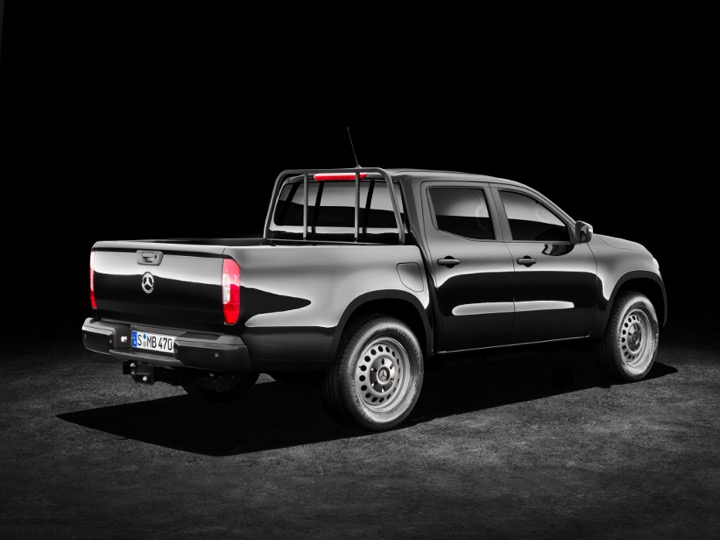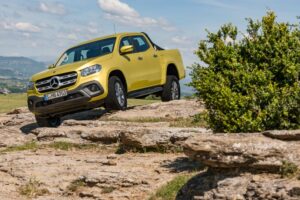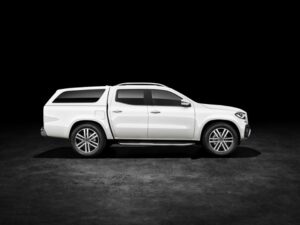– By Marc Sibbald –
Earlier this month Mercedes-Benz held the global launch of their new X-Class ute. The production version looks different from the concept as expected. Though what I didn’t expect was it to look like a Nissan Navara. So I’m asking – How much more will people be willing to pay for a three pointed star?
As I tried to answer this question in my own mind I became angry at the rampant consumerism in the world that has created a market for a luxury brand to build a utility. Which by it’s name is meant to be practical, rugged and affordable. (My colleagues in the Fleet Auto News office pleaded with me to get off this soap box but as you’ve now realised by reading this – I didn’t).
The creation of the ‘Aussie’ ute is attributed to Lewis Bandt, a Ford engineer based in Geelong, who responded to requests from farmers in the 1930s for a vehicle that served two purposes. It’s suggested that one of the requests came from a farmer’s wife that wanted a vehicle that could be used to drive to church on Sundays and carry the pigs to market on Monday.
So the ute has gone from practical and humble beginnings to a lifestyle vehicle for people to show off their wealth in less than 100 years.
I acknowledge this trend has been developing for a long time. The first example I remember was the Holden VG Maloo ute in 1990. At the time it created a new segment for the light commercial vehicle market. Tradies were able to show their loyalties in the Holden v Ford battle while demonstrating their financial success and keeping some blue collar credibility.
Well before the Maloo, Toyota introduced the SR5 model in the second generation Hi-Lux circa 1975. This was a big thing for light commercial vehicles at the time and buyers got an ‘upscale trim package’ for the price premium. In the 1980s the extra features in the SR5 extended to twin bucket seats and a two speaker radio (power steering and air conditioning were still optional extras).
The current Hi-Lux SR5 is definitely a different vehicle to the early models and is as almost as comfortable as a Camry to drive. And buyers aren’t driving to church on Sunday and loading the pigs to take to market on Monday. They’re using the dual-cab models to carry family members and the tray for their weekend pursuits. But its still a Toyota with an unbreakable reputation that hasn’t strayed from its core task of carrying goods.
When Volkswagen launched the Amarok in 2010 the game changed for the ute segment. It was a brand new vehicle that raised the bar in safety and passenger comfort. It came with German credibility and engineering. It was designed to take on the world in a growing market segment. And it wasn’t a joint venture vehicle that shared its engineering and technology with another brand; it was a Volkswagen.
And while it provided a spacious interior with nice trim and better ride comfort, it didn’t rely on its badge. It competed head to head with the market leader (Hi-Lux), and other strong competition, to be awarded the International Pick-Up of the Year in 2011.
So, back to the X-Class. Mercedes-Benz said in the press kit, “The X-Class is aimed at very different customer groups: land owners and farmers in Argentina, business owners and building contractors (aka tradies) in Australia, families with an affinity for premium products in Brazil, trend-conscious individualists in South Africa and Great Britain as well as sporty adventurers in New Zealand and Germany.”
I have no doubt it will have a beautiful interior and feel like a Mercedes. The suspension has been tuned by the Mercedes engineers and the three engine options (two four cylinders and one V6) will be tweaked to ensure the performance matches buyer expectations. And as with all Mercedes-Benz vehicles the list of safety features will be extensive and market leading.
But how much extra will people pay for a three pointed star with a one tonne payload compared to an unbreakable Hi-Lux, or it’s brother the Navara? I guess we’ll have to wait and see.









